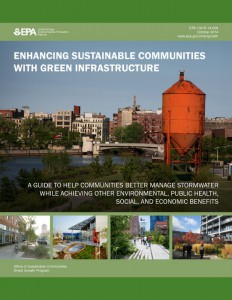 On Oct. 27, the U.S. Environmental Protection Agency (EPA) released the report “Enhancing Sustainable Communities with Green Infrastructure.” The guidebook is a resource to help groups, such as local governments, nonprofits, utilities, and others, use green infrastructure to improve communities and save money. The report discusses the many benefits of green infrastructure beyond improving water quality, to the purpose of overall smart growth and sustainability. In the report, EPA states that “Communities across the country want to protect their water quality while also getting the greatest possible benefit out of every investment they make.”
On Oct. 27, the U.S. Environmental Protection Agency (EPA) released the report “Enhancing Sustainable Communities with Green Infrastructure.” The guidebook is a resource to help groups, such as local governments, nonprofits, utilities, and others, use green infrastructure to improve communities and save money. The report discusses the many benefits of green infrastructure beyond improving water quality, to the purpose of overall smart growth and sustainability. In the report, EPA states that “Communities across the country want to protect their water quality while also getting the greatest possible benefit out of every investment they make.”
The report addresses challenges communities face that limit green infrastructure implementation, including technical, regulatory, financial, and institutional obstacles. It is intended to help communities create green infrastructure plans that overcome these obstacles and include “clear goals, an assessment of assets and opportunities, a comprehensive look at how to achieve implementation, a means for funding implementation, a way to monitor and measure progress toward achieving the community’s goals, and a strategy for long-term operations and maintenance.”
The announcement coincided with the agency’s second Community Summit on Green Infrastructure, which occurred in Cleveland. EPA calls both the city and Northeast Ohio Regional Sewer District (NEORSD) “innovators in using green infrastructure for its water quality benefits and its community benefits.” NEORSD’s combined green and gray infrastructure scheme, Project Clean Lake, will help control additional combined sewer overflow volume while reducing costs by $87 million compared to using traditional infrastructure alone. Read more in EPA’s blog about the report.





